Evaluation of Personal Ecological Footprints for Climate Change Mitigation and Adaptation: A Case Study in the UK
Abstract
1. Introduction
What Is Different About This Study?
2. Literature Review
2.1. Understanding Ecological Footprints: A Basic Introduction
2.2. Human Ecological Footprints and the Crisis of Biodiversity
2.3. The Impact of Human Activity on Global Ecological Change
2.4. Ecological Footprint Analysis for the UK as a Developed Country
3. Methods
3.1. Survey
3.2. Online Calculator
3.3. The Methodology Adopted and Its Linkage to Research Objectives
3.4. Data Collection Tools and Implementation
3.5. Purpose of Data Collection
- Demographic Information:Questions about gender and age group provide context for analysing ecological footprint variations across different demographic groups.
- Employment and Transportation Patterns:Questions regarding employment status, workplace location, and modes of transportation help assess carbon emissions related to commuting and professional activities.
- Household Energy and Utility Consumption:Participants are queried about the size and type of their residence, heating sources, monthly utility expenses (gas, electricity, and water), and insulation upgrades. These inputs are critical for understanding home energy efficiency and carbon footprints.
- Consumption and Waste Management:Questions about food habits, plastic use, and recycling behaviours reveal the participants’ level of engagement with sustainable consumption practices.
- Travel and Mobility:Information on car ownership, miles driven, vehicle type, and usage of public transport and flights helps estimate transportation-related emissions.
- Awareness, Cultural Norms, and Economic Factors:Participants are asked about cultural influences, social norms, and economic conditions that impact their adoption of sustainable behaviours.
- Renewable Energy and Energy-Saving Practices:The survey and calculator include questions about familiarity with and willingness to adopt renewable energy technologies, such as solar panels and heat pumps.
- Carbon Footprint Calculation:By examining transportation, housing, and consumption patterns, the survey enables the estimation of individuals’ carbon footprints.
- Behavioural Insights:Understanding participants’ willingness to adopt sustainable practices and barriers to such adoption provides valuable insights for policy recommendations.
- Awareness Assessment:Questions about participants’ familiarity with renewable technologies and sustainable behaviours help gauge the effectiveness of public awareness initiatives.
- Targeted Sustainability programmes:The data can guide the development of tailored programmes to reduce ecological footprints, promote energy efficiency, and encourage sustainable lifestyles.
4. Results and Discussion
4.1. Identification of Key Factors Influencing Individual Behaviours
4.1.1. Energy Consumption
4.1.2. Water Usage Habits
4.1.3. Transportation Methods
4.1.4. Ethnic and Cultural Norms
4.2. Access to Knowledge About Sustainable Behaviour Among Participants
4.3. Investigation of Participants’ Beliefs in Renewable Energies
4.4. Participants’ Knowledge About Recent Technologies in Renewable Energy
4.5. Participants’ Willingness to Adopt Technologies in Their Houses
4.6. Calculation of Individuals’ Ecological Impact Through an Online Survey
4.6.1. Climate Hero
4.6.2. Climate Friend
Critical Discussion
4.6.3. Climate Consumer
4.6.4. Climate Villain
5. Conclusions
- The study’s findings on the age distribution of respondents provide concrete conclusions about how generational differences shape ecological footprints and attitudes toward climate change. The largest demographic group, participants aged 35 to 44 (49.1%), offers significant insights due to their substantial representation. This age group is likely to balance career responsibilities with family commitments, resulting in larger homes and higher energy consumption for heating, cooling, and lighting. Their established lifestyles and consumption patterns make them key contributors to understanding household energy use and sustainability challenges. These findings underscore the importance of tailoring climate action strategies to different generational needs. For instance, middle-aged adults might benefit from policies or incentives promoting energy-efficient homes, while younger and older generations might respond better to education or support for sustainable behaviours;
- The study reveals that 67.9% of respondents worked full-time, highlighting the significant role employment status plays in shaping ecological footprints. Full-time employment, associated with steady incomes and established consumption patterns, enables individuals to engage in higher levels of consumption, such as frequent use of personal vehicles, increased energy demands for larger homes, and higher purchasing power for goods and services. These behaviours collectively contribute to larger ecological footprints. However, this demographic also possesses the financial capacity to adopt sustainable practices, such as investing in renewable energy, energy-efficient appliances, or electric vehicles, which could mitigate their environmental impact. These findings underline the importance of tailoring climate action strategies to accommodate different employment statuses. For example, policies targeting full-time workers could focus on incentivising the adoption of low-carbon technologies and sustainable transportation options, leveraging their financial stability. At the same time, providing accessible and affordable eco-friendly solutions for part-time or unemployed individuals could ensure inclusivity in climate mitigation efforts. By reflecting on the interplay between employment status, income, and lifestyle choices, the study establishes a robust foundation for understanding and addressing the complex drivers of ecological footprints;
- The study highlights a small but significant portion of participants who have adopted advanced energy-saving technologies such as solar panels and smart home systems. These participants likely represent early adopters of innovative solutions that optimise energy consumption and contribute to long-term sustainability. Their engagement serves as a benchmark for broader adoption across diverse socioeconomic groups. These findings underscore the need for comprehensive policies to promote sustainable energy practices. Financial incentives and subsidies for solar panels, programmable thermostats, and smart home technologies could make these innovations more accessible to a broader population.
- The study reveals that while most participants demonstrate some level of awareness regarding water conservation, there remains significant variation in the extent of their proactive efforts. However, only 16.4% adopt advanced measures like installing low-flow fixtures, and a mere 1.8% practice comprehensive strategies such as using rain barrels and water-efficient landscaping. Economic and household factors appear to influence water consumption patterns significantly. Households with higher water bills may reflect inefficient practices or larger family sizes, while smaller households or those with lower water usage may naturally have reduced bills. However, the low adoption rate of comprehensive conservation practices underscores the need for targeted interventions. Awareness campaigns could focus on empowering individuals with actionable knowledge, such as fixing leaks and adopting water-saving landscaping techniques. Economic incentives, like tiered water pricing, could further encourage conservation by increasing the financial benefits of reducing consumption. Community-level programmes such as rain barrel workshops or demonstration gardens could provide practical examples of advanced conservation methods, inspiring broader participation. These findings suggest that addressing both behavioural and systemic barriers is critical to fostering widespread adoption of water-saving practices. By implementing a multi-pronged strategy that includes education, economic incentives, and technological innovation, significant strides can be made toward sustainable water consumption practices;
- The study revealed that 65.4% of participants preferred car usage over other modes of transportation, reflecting a heavy dependency on private vehicles. The relatively low adoption of public transportation suggests that current systems may not adequately meet the needs of the population. Issues such as infrequent schedules, overcrowding, safety concerns, and poor accessibility undermine the appeal of buses, trains, and subways. Similarly, the limited use of bicycles and walking can be attributed to factors such as insufficient infrastructure (bike lanes and pedestrian pathways), perceived inconvenience, and potential climate-related barriers. These challenges highlight the intersection of urban planning, societal behaviours, and infrastructure limitations in shaping transportation choices. From a sustainability perspective, the high reliance on cars is a significant concern due to their carbon emissions and environmental impact. Shifting towards more sustainable modes of transportation, such as public transit, walking, or cycling, requires addressing both systemic barriers and behavioural preferences. Cities with well-developed and reliable public transportation systems, such as London and New York, demonstrate higher public transit usage, underscoring the importance of infrastructure investments in influencing behaviour. Similarly, cities like Amsterdam and Copenhagen, with extensive bike lane networks and pedestrian-friendly urban designs, highlight how infrastructure improvements can promote active transportation. To address these issues, policymakers and urban planners should adopt a multifaceted approach. Investments in expanding and improving public transportation systems, such as increasing service coverage, frequency, and safety are critical. Promoting active transportation modes like walking and cycling through dedicated infrastructure and addressing safety concerns can also encourage broader adoption. Additionally, targeted incentives, such as subsidies for public transit passes, tax breaks for bicycle purchases, or congestion charges in urban centers, can help shift preferences away from car usage. Environmental education campaigns can further support these efforts by fostering awareness about the ecological and health benefits of sustainable transportation. Special consideration must also be given to affordability and accessibility, ensuring that public transit systems meet the diverse needs of all population segments, including individuals with disabilities or lower-income households;
- The survey findings reveal that 16.7% of participants are uninformed about sustainable behaviours and struggle to access reliable information, highlighting a significant barrier to adopting sustainable practices. This lack of foundational knowledge, coupled with difficulty in accessing accurate and consistent information, underscores the need for a more robust approach to education and information dissemination. For those with some awareness but limited access to trustworthy sources, the confusion caused by conflicting messages exacerbates the challenge, preventing informed decision-making and action. Additionally, even individuals who are relatively well-informed face difficulties staying up to date with evolving sustainability practices, indicating the need for continuous education and periodic updates. To address these challenges, educational initiatives must be tailored to different awareness levels, ensuring that those who are uninformed receive basic knowledge, while others receive updated, reliable information. Collaboration between educators, environmental organisations, and other stakeholders is crucial to creating a coherent, accessible information environment that promotes clarity and consistency across platforms, ultimately fostering greater adoption of sustainable behaviours;
- The survey results reveal a clear and widespread acceptance of renewable energy technologies, with no participants expressing scepticism about their efficiency or reliability. This indicates that the primary challenge to the adoption of renewable energy does not stem from doubts about their efficacy, but rather from practical and economic barriers. The lack of scepticism towards renewable energy underscores the success of awareness campaigns and technological advancements in shaping public perceptions. However, it also points to the fact that overcoming the practical and economic barriers to adoption remains the key challenge. To accelerate the transition to renewable energy, it is crucial to address the affordability and accessibility issues through targeted policies, financial support, and continuous public education. By focusing on these areas, the widespread acceptance of renewable energy can be translated into broader adoption, helping to reduce carbon footprints and foster a culture of sustainability;
- The survey reveals a concerning gap in the public’s familiarity with renewable energy technologies, with 40.9% of participants reporting only slight familiarity or none at all. This highlights a significant barrier to the widespread adoption of renewable energy, suggesting that many individuals are either unaware of the technologies or lack the knowledge necessary to engage with them meaningfully. Several factors may contribute to this lack of familiarity, including an inadequate education system, limited media coverage, and the perception that renewable energy solutions are too complex or expensive to implement. Additionally, the lack of consistent and comprehensive media coverage around renewable energy advancements may contribute to the public’s limited exposure to these technologies. As a result, many individuals might view renewable energy as too technical or costly, reinforcing misconceptions and discouraging adoption. To address these challenges, integrating renewable energy education into school curricula and community programmes is crucial. By introducing renewable energy concepts early and providing continuous education, individuals may become more familiar with the practical and economic benefits of these technologies;
- The 4.5% of participants who prefer traditional heating systems and are unlikely to adopt new technologies represent a small but significant group resistant to change. Overcoming their reluctance would require targeted strategies, such as demonstrating tangible benefits like cost savings, efficiency, and environmental impact. However, the cost-effectiveness of such efforts should be critically evaluated given their small size. For instance, intensive educational campaigns or tailored incentives might yield low returns on investment if these individuals remain entrenched in their preferences. The likelihood of success depends on addressing deeply rooted barriers such as scepticism, comfort with existing systems, and perceived risks associated with new technologies. While this group’s adoption would contribute incrementally to climate change mitigation, the broader impact might be marginal compared to the efforts required to convince them. Given the strong commitment of 36.4% of participants already willing to adopt sustainable technologies and the openness of the 40.9% who prioritise practicality, focusing resources on these more receptive groups may deliver greater environmental benefits. Thus, while targeted measures could be considered for this resistant minority, they should not detract from broader initiatives aimed at groups with higher adoption potential.
- It is evident that the calculator’s personalised feedback and recommendations play an imperative role in guiding individuals towards more sustainable lifestyle choices. Participants were given clear and actionable steps to reduce food waste, minimise plastic use, and change their travel habits.
5.1. Limitations
5.2. Recommendations
Author Contributions
Funding
Institutional Review Board Statement
Informed Consent Statement
Data Availability Statement
Conflicts of Interest
References
- Baus, D. Overpopulation and the Impact on the Environment. Master’s Thesis, The Graduate Centre, City University of New York, New York, NY, USA, 2017. Available online: https://academicworks.cuny.edu/cgi/viewcontent.cgi?article=2929&context=gc_etds (accessed on 30 July 2024).
- Zhai, J.; Han, B.; Li, H.; Ren, W.; Xue, B. Accounting for the nitrogen footprint of food production in Chinese provinces during 1998–2018. J. Clean. Prod. 2023, 389, 136011. [Google Scholar] [CrossRef]
- Lian, M. The impact of cleaner energy sources, advanced technology firms, and economic expansion on ecological footprints is critical in sustainable development. Heliyon 2024, 10, e31100. [Google Scholar] [CrossRef] [PubMed]
- Klugesherz, J.; Sanderson, M. Good for the soil, but good for the farmer? Addiction and recovery in transitions to regenerative agriculture. J. Rural. Stud. 2023, 103, 103123. [Google Scholar] [CrossRef]
- Wang, L.; Li, L.; Cheng, K.; Pan, G. A Comprehensive evaluation of environmental footprints of regional crop production: A case study of Chizhou City, China. Ecol. Econ. 2019, 164, 106360. [Google Scholar] [CrossRef]
- Furumai, H. Rainwater and reclaimed wastewater for sustainable urban water use. Phys. Chem. Earth Parts A/B/C 2008, 33, 340–346. [Google Scholar] [CrossRef]
- Wackernagel, M.; Rees, W. Our Ecological Footprint: Reducing Human Impact on the Earth; New Society Publishers: Gabriola Island, BC, Canada, 1999. [Google Scholar] [CrossRef]
- Kibria, G. Ecological Footprint in Bangladesh: Identifying the Intensity of Economic Complexity and Natural Resources. Heliyon 2023, 9, e14747. [Google Scholar] [CrossRef] [PubMed]
- ClimateHero. Ecological Footprint Calculator. 2022. Available online: https://ecological-footprint-calculator.climatehero.org/ (accessed on 17 July 2024).
- WWF. Living Planet Report. Bending the Curve of Biodiversity Loss. 2020. Available online: https://livingplanet.panda.org/en-us/ (accessed on 16 August 2024).
- Rees, W. Ecological Footprint, Concept of. In Elsevier Reference Collection in Life Sciences; University of British Columbia: Vancouver, BC, Canada, 2017. [Google Scholar] [CrossRef]
- Carmona, P.; Stef, N.; Jabeur, S.; Zaied, Y. Climate change and government policy: Fresh insights from complexity theory. J. Environ. Manag. 2023, 338, 117831. Available online: https://www.sciencedirect.com/science/article/pii/S0301479723006199 (accessed on 20 July 2024). [CrossRef] [PubMed]
- Walsh, C.; McLoone, A.; Oregan, B.; Moles, R. The application of the ecological footprint in two Irish urban areas: Limerick and Belfast. Ir. Geogr. 2006, 39, 1–21. Available online: https://www.tandfonline.com/doi/abs/10.1080/00750770609555863 (accessed on 18 July 2024). [CrossRef]
- Balsalobre, D.; Nur, T.; Topaloglu, E.; Evcimen, C. Assessing the impact of the economic complexity on the ecological footprint in G7 countries: Fresh evidence under human development and energy innovation processes. Gondwana Res. 2024, 127, 226–245. Available online: https://www.sciencedirect.com/science/article/pii/S1342937X23000941 (accessed on 20 July 2024). [CrossRef]
- Chenet, H. Climate change and biodiversity loss: New territories for financial authorities. Curr. Opin. Environ. Sustain. 2024, 68, 101449. Available online: https://www.sciencedirect.com/science/article/pii/S1877343524000368 (accessed on 22 July 2024). [CrossRef]
- National Geographic. Newsroom. The Global Impacts of Habitat Destruction. 2019. Available online: https://news.nationalgeographic.org/the-global-impacts-of-habitat-destruction/ (accessed on 22 July 2024).
- National Wildlife Federation. Overexploitation. Wildlife at Risk. 2008. Available online: https://www.nwf.org/Educational-Resources/Wildlife-Guide/Threats-to-Wildlife/Overexploitation (accessed on 24 July 2024).
- Rosa, L. Defenders of Wildlife. Pollution, One of the Five Drivers of Biodiversity Loss. 2022. Available online: https://defenders.org/blog/2022/12/pollution-one-of-five-drivers-of-biodiversity-loss (accessed on 24 July 2024).
- Opoku, E.; Boachie, M. Energy Policy Environmental Impact of Industrialization and Foreign Direct Investment. 2022. Available online: https://www.sciencedirect.com/science/article/abs/pii/S0301421519307645 (accessed on 25 July 2024).
- Peterson, J.; Volder, A. The Urban Physical Environment: Temperature and Urban Heat Islands. Urban Ecosyst. Ecol. 2010, 55, 29–56. [Google Scholar] [CrossRef]
- United Nations. Paris Agreement. 2015. Available online: https://unfccc.int/process-and-meetings/the-paris-agreement/the-paris-agreement (accessed on 30 July 2024).
- Centre for Climate and Energy Solution. Carbon Prising. Carbon Tax Basics. 2024. Available online: https://www.c2es.org/content/carbon-tax-basics/ (accessed on 1 August 2024).
- Andersson, F. Economic inequality and the ecological footprint: Time-varying estimates for four developed economies, 1962–2021. Ecol. Econ. 2024, 220, 108185. Available online: https://www.sciencedirect.com/science/article/pii/S092180092400082X (accessed on 10 August 2024). [CrossRef]
- Angelo, C.; Gloinson, E.; Draper, A.; Guthrie, S. Rand Europe. In Food Consumption in the UK; RAND: Santa Monica, CA, USA, 2020; Available online: https://www.rand.org/pubs/research_reports/RR4379.html (accessed on 10 August 2024).
- Holmes, G.; Hay, R.; Davies, E.; Hill, J.; Barrett, J.; Style, D.; Vause, E.; Brown, K. Committee on Climate Change UK Housing: Fit for the Future? 2019. Available online: https://www.theccc.org.uk/wp-content/uploads/2019/02/UK-housing-Fit-for-the-future-CCC-2019.pdf (accessed on 10 August 2024).
- BBC. Smart Guide to Climate Change. How Our Daily Travel Harms the Planet. 2020. Available online: https://www.bbc.com/future/article/20200317-climate-change-cut-carbon-emissions-from-your-commute (accessed on 10 August 2024).
- Google Forms Get Insights Quickly, with Google Forms. 2008. Available online: https://www.google.com/forms/about/ (accessed on 22 August 2024).
- Bunge, A.C.; Mazac, R.; Clark, M.; Wood, A.; Gordon, L. Sustainability benefits of transitioning from current diets to plant-based alternatives or whole-food diets in Sweden. Nat. Commun. 2024, 15, 951. [Google Scholar] [CrossRef] [PubMed]


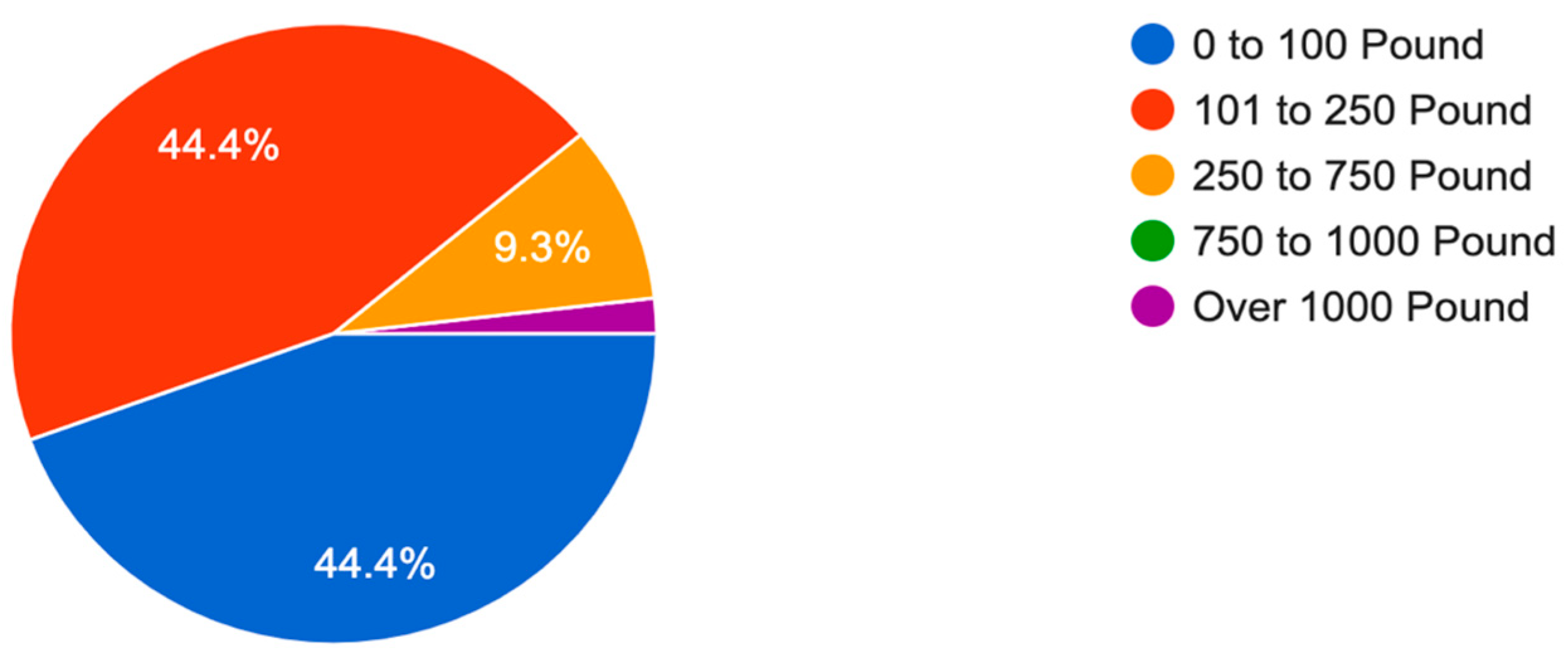
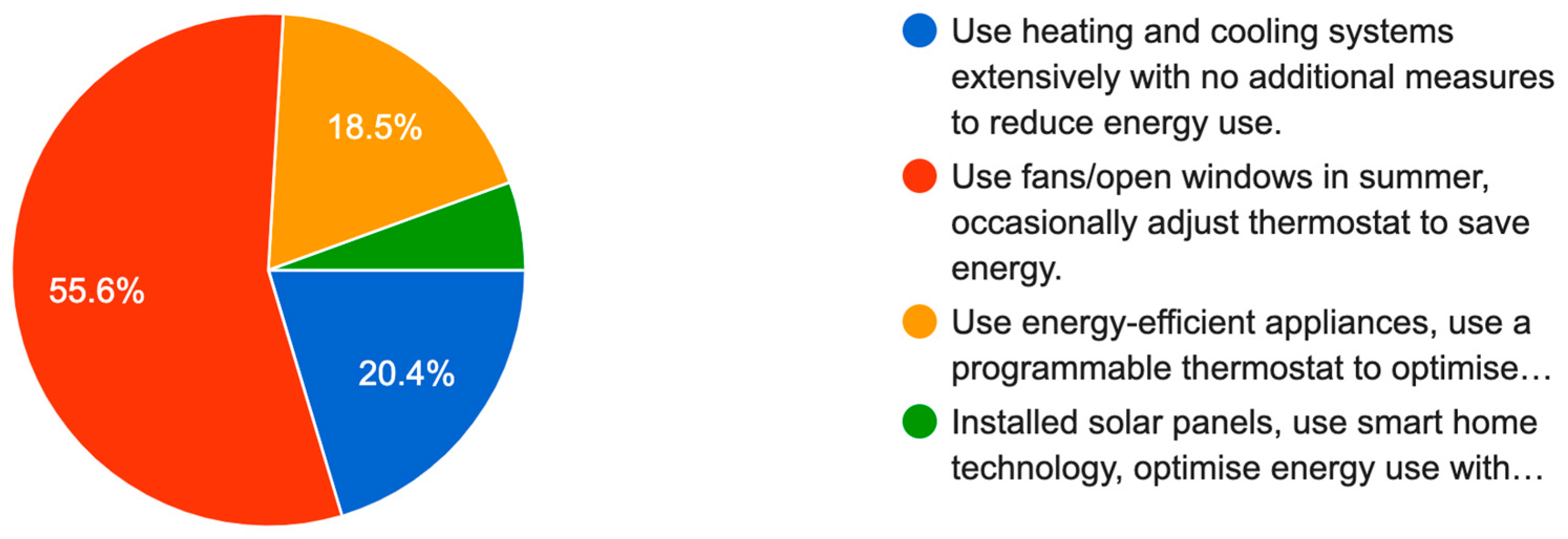
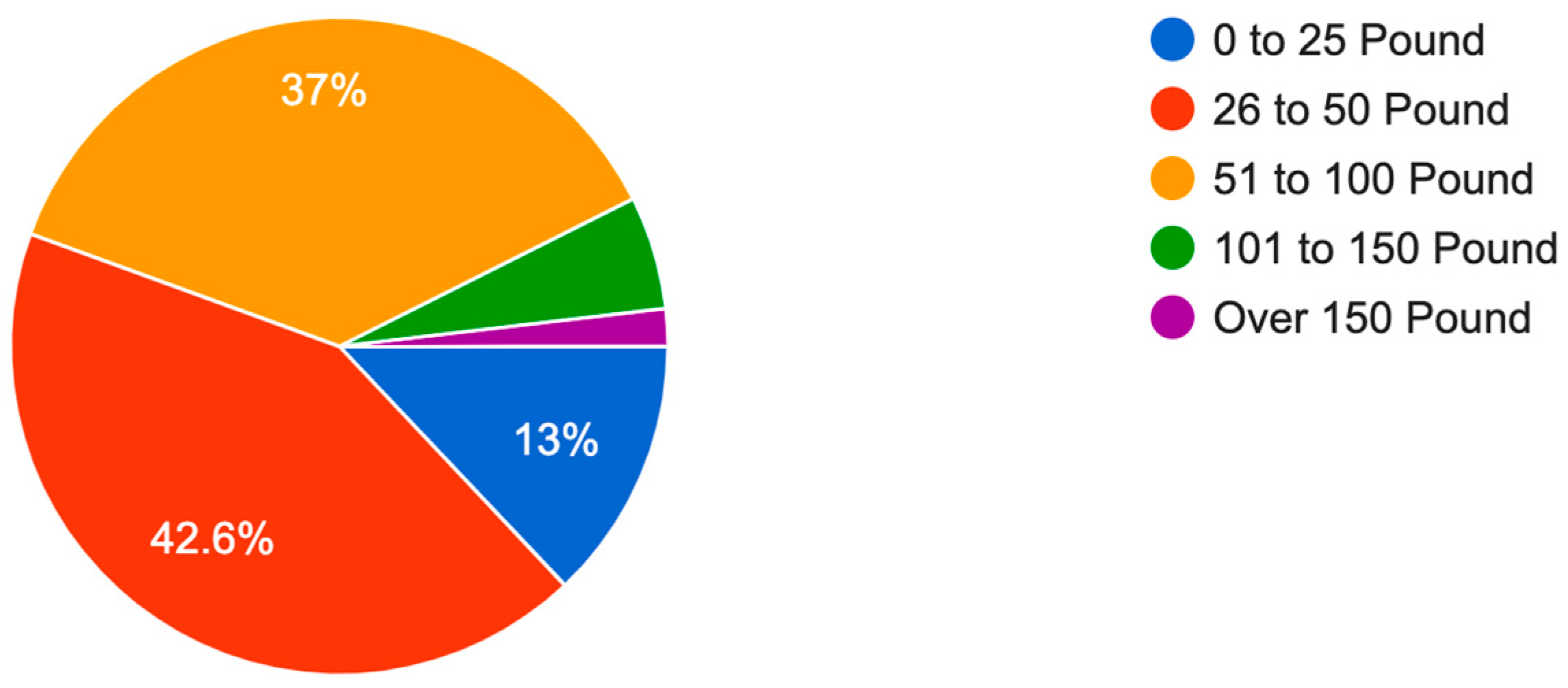



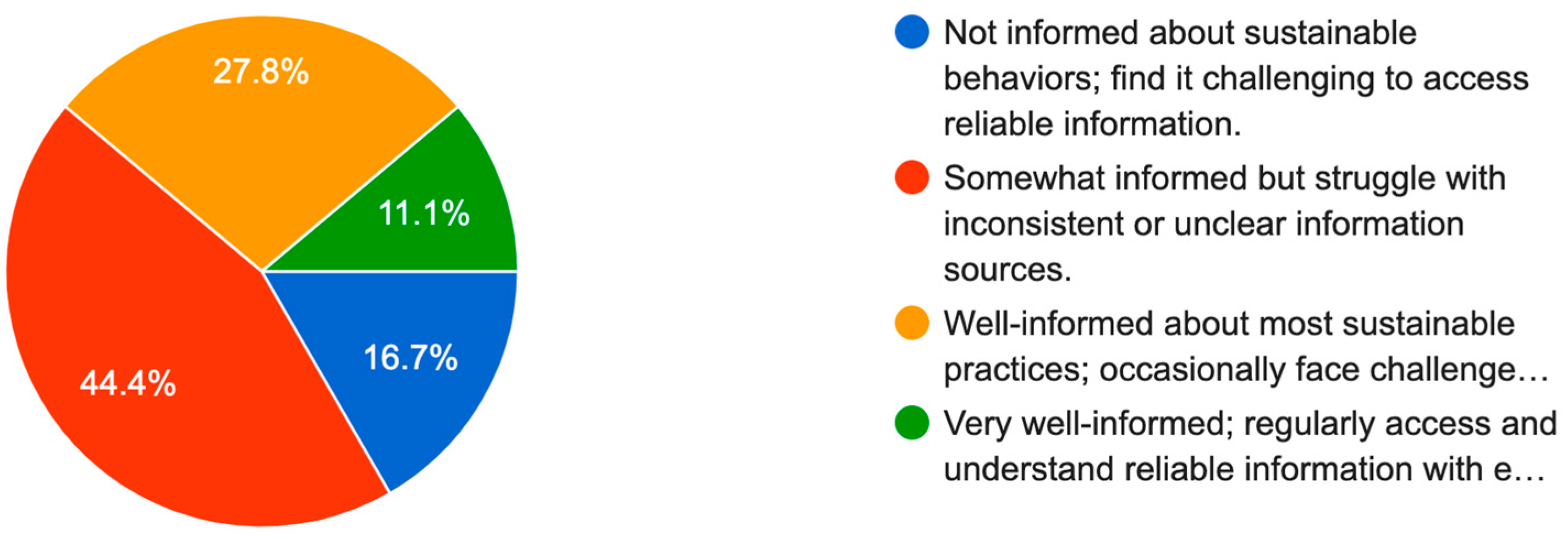
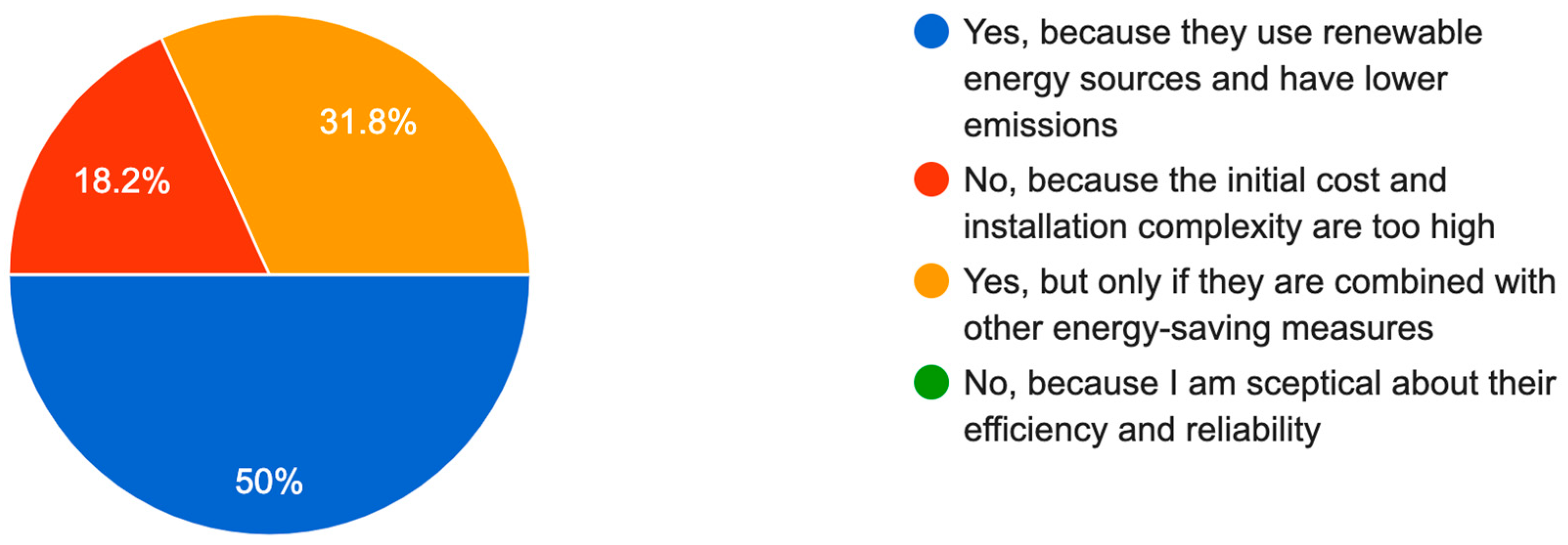

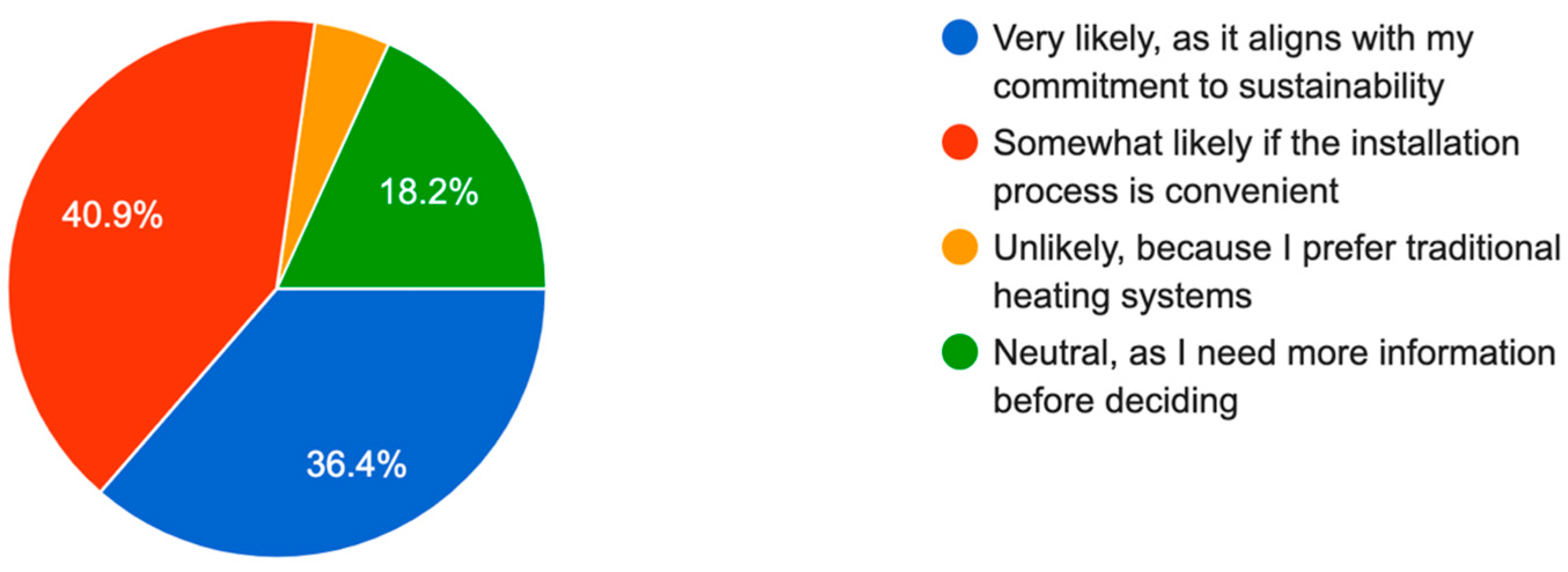


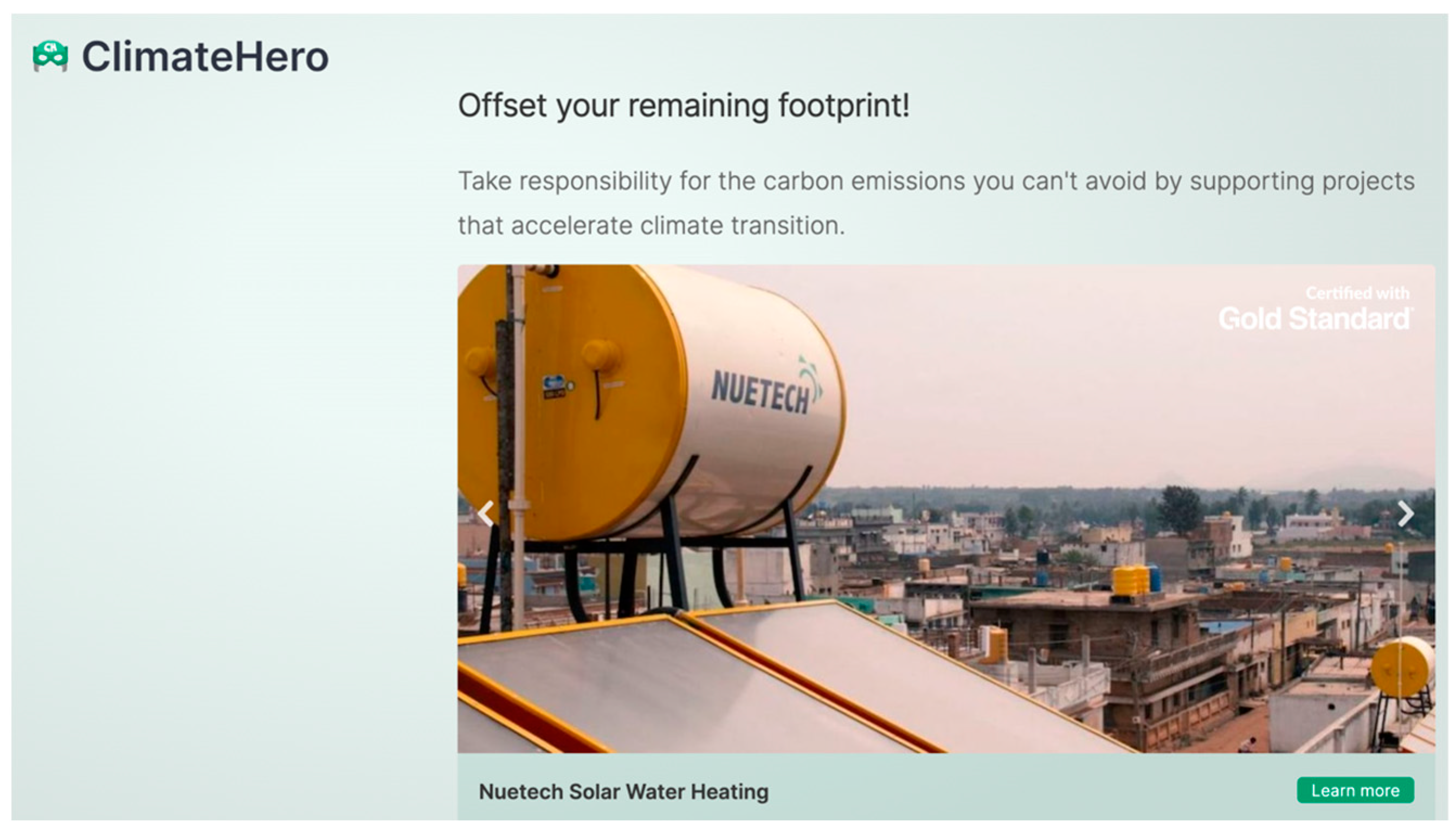





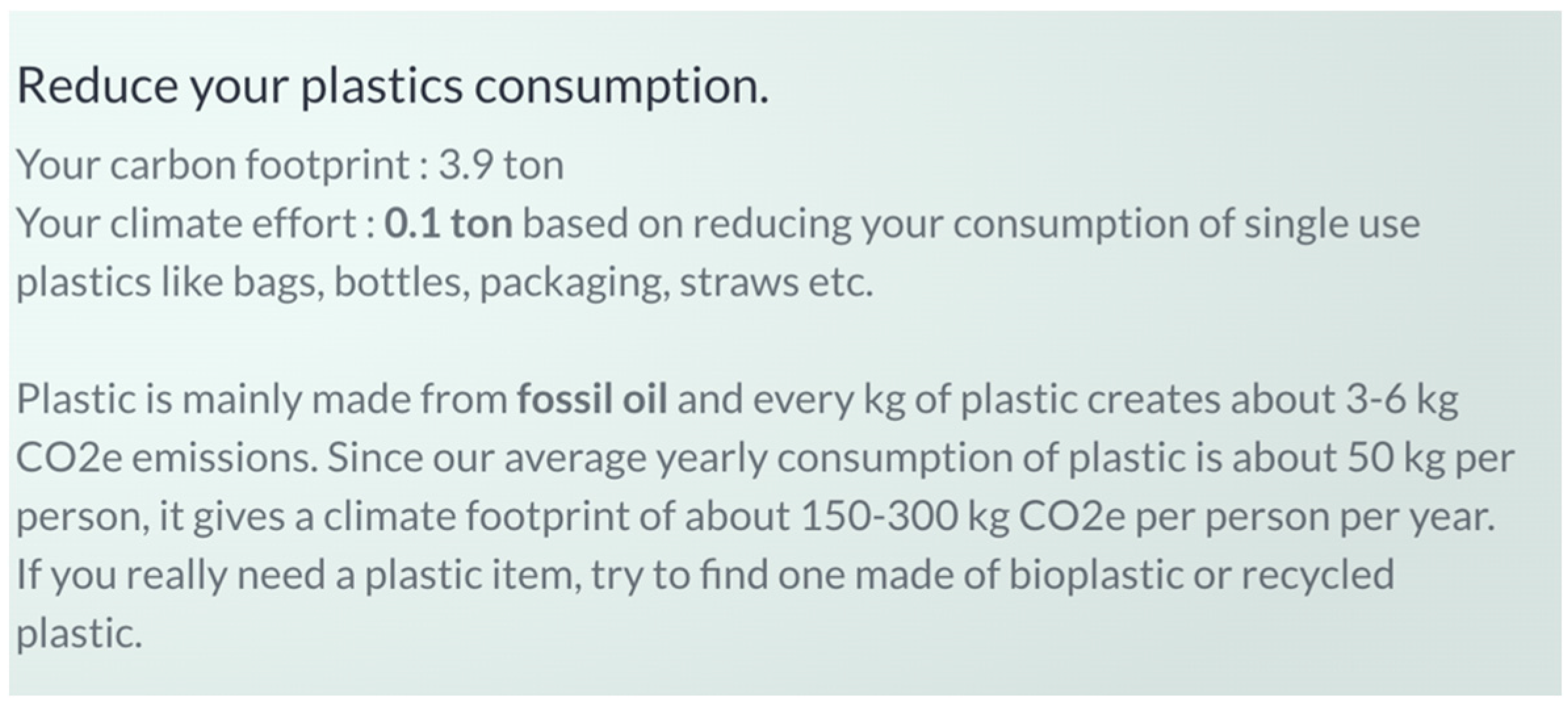
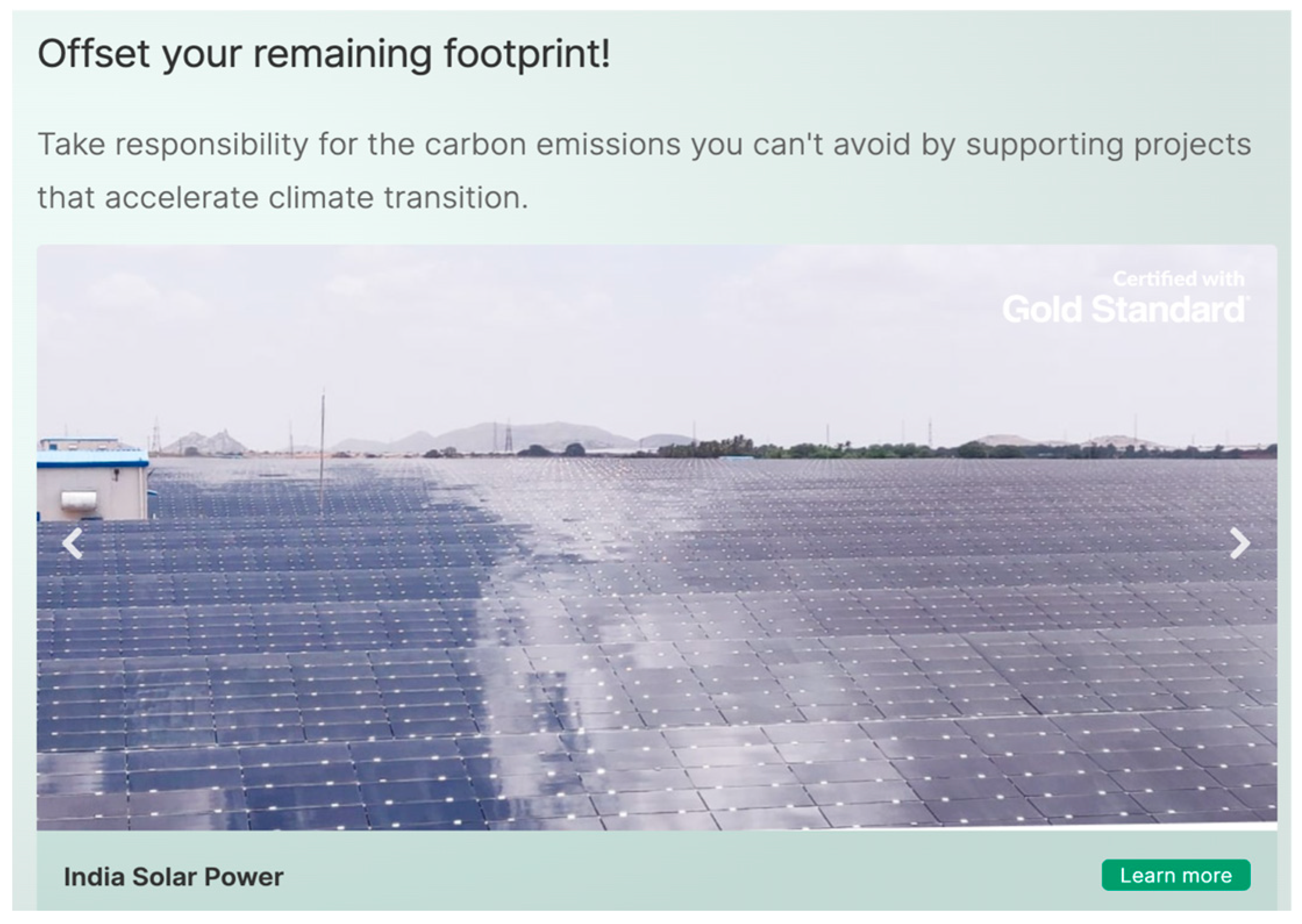


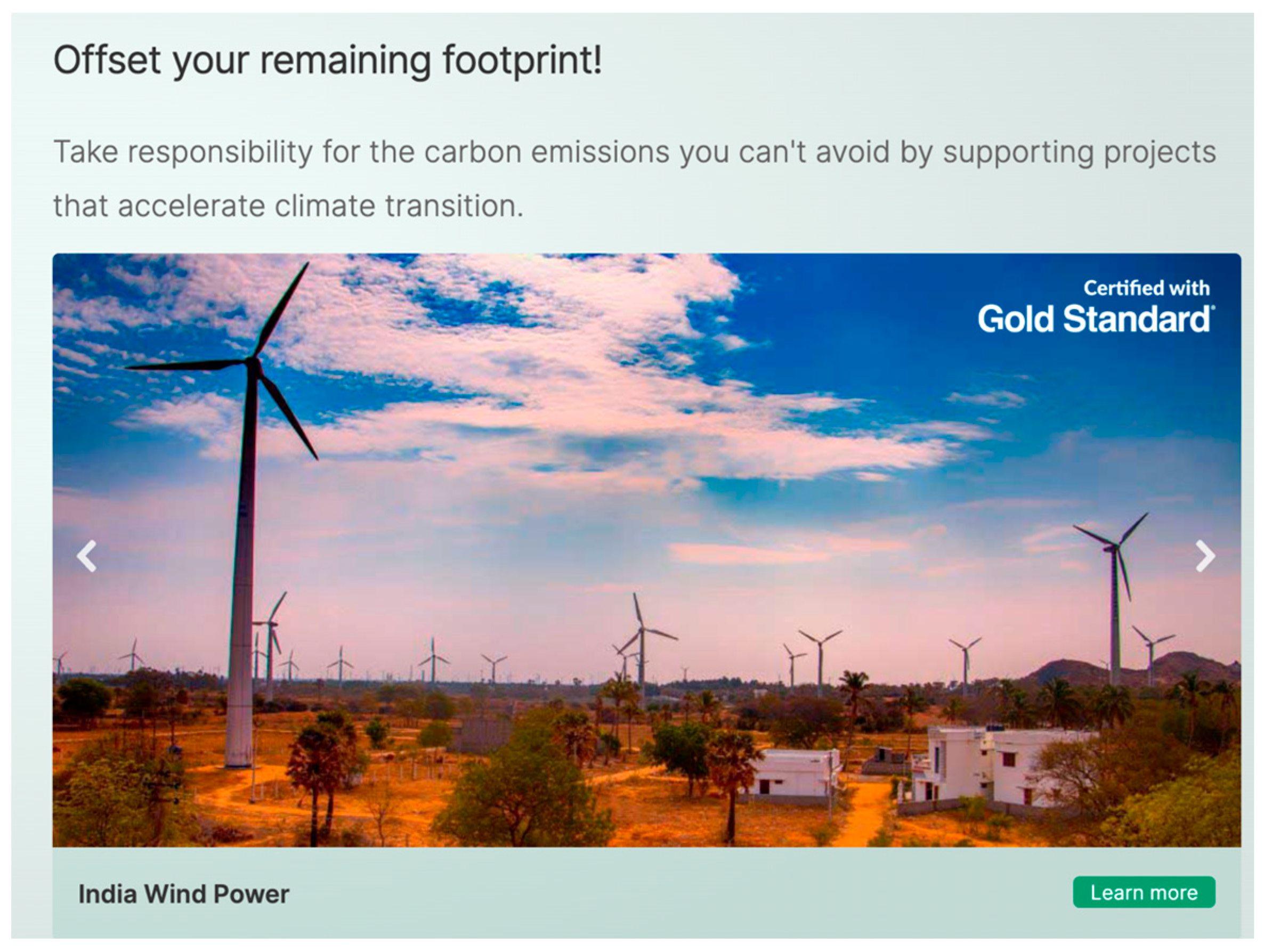

Disclaimer/Publisher’s Note: The statements, opinions and data contained in all publications are solely those of the individual author(s) and contributor(s) and not of MDPI and/or the editor(s). MDPI and/or the editor(s) disclaim responsibility for any injury to people or property resulting from any ideas, methods, instructions or products referred to in the content. |
© 2025 by the authors. Licensee MDPI, Basel, Switzerland. This article is an open access article distributed under the terms and conditions of the Creative Commons Attribution (CC BY) license (https://creativecommons.org/licenses/by/4.0/).
Share and Cite
Abugabal, A.; Abdellatif, M.; Bras, A.A.; Brady, L. Evaluation of Personal Ecological Footprints for Climate Change Mitigation and Adaptation: A Case Study in the UK. Sustainability 2025, 17, 5415. https://doi.org/10.3390/su17125415
Abugabal A, Abdellatif M, Bras AA, Brady L. Evaluation of Personal Ecological Footprints for Climate Change Mitigation and Adaptation: A Case Study in the UK. Sustainability. 2025; 17(12):5415. https://doi.org/10.3390/su17125415
Chicago/Turabian StyleAbugabal, Ahmed, Mawada Abdellatif, Ana Armada Bras, and Laurence Brady. 2025. "Evaluation of Personal Ecological Footprints for Climate Change Mitigation and Adaptation: A Case Study in the UK" Sustainability 17, no. 12: 5415. https://doi.org/10.3390/su17125415
APA StyleAbugabal, A., Abdellatif, M., Bras, A. A., & Brady, L. (2025). Evaluation of Personal Ecological Footprints for Climate Change Mitigation and Adaptation: A Case Study in the UK. Sustainability, 17(12), 5415. https://doi.org/10.3390/su17125415









